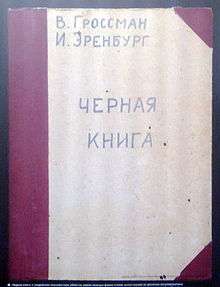Black Book (World War II)
The Black Book: The Ruthless Murder of Jews by German-Fascist Invaders Throughout the Temporarily-Occupied Regions of the Soviet Union and in the German Nazi Death Camps established on occupied Polish soil during the War 1941–1945 alternatively The Black Book of the Holocaust, or simply The Black Book, (Russian: Чёрная Книга, Chornaya Kniga; Yiddish: דאָס שוואַרצע בוך, Dos shvartse bukh) was a result of the collaborative effort by the Jewish Anti-Fascist Committee (JAC) and members of the American Jewish community to document the anti-Jewish crimes of the Holocaust and the participation of Jews in the fighting and the resistance movement against the Nazis during World War II.
Background
Prominent Jewish Soviet writers and journalists Ilya Ehrenburg and Vasily Grossman served as war reporters for the Red Army. Grossman's documentary reports of the opening of the Treblinka and Majdanek extermination camps were some of the first eyewitness accounts — as early as 1943 — of what later became known as the Shoah. His article The Treblinka Hell (Треблинский ад, 1944) was disseminated at the Nuremberg Trials as a document for the prosecution.
Manuscripts and publications

In 1944–1945, based on their own experiences and on other documents they collected, Ehrenburg and Grossman produced two volumes under the title Murder of the People in Yiddish and handed the manuscript to the JAC. Copies were sent to the United States, the British mandate of Palestine (now Israel) and Romania in 1946, and excerpts were published in the United States in English under the title Black Book that same year. In Romania, a part of the manuscript was also published in 1946. It was also printed in Israel. A handwritten manuscript of the book is held at Yad Vashem.
The fate of the Black Book in the USSR
According to Ehrenburg, the mandatory State literary commission did not commit to publish the Book in October 1944: "Instead of a straight answer, the resolution was: 'write the book, and if it comes out well, it would be published.' But it is not we who are the authors, it is the fascists… What does that mean, 'comes out well' this is not a novel, it is a document."
The Book was partially printed in the Soviet Union by the Yiddish publisher Der Emes, however the entire edition, the typefaces, as well as the manuscript, were destroyed. First the censors ordered changes in the text to conceal the specifically anti-Jewish character of the atrocities and to downplay the role of Ukrainians who worked as Nazi police officers. Then in 1948 the Soviet edition of the book was scrapped completely. The collection of original documents that Ehrenburg handed down to the Vilnius Jewish Museum after the war was secretly returned to him upon the Museum's termination in 1948. The JAC was also disbanded, its members purged at the outset of the state campaign against the "rootless cosmopolitans", a Soviet euphemism for Jews. (See also the Doctors' plot). Typically, the official Soviet policy regarding the Holocaust was to present it as atrocities committed against Soviet citizens, without acknowledging the genocide of the Jews.
A Russian-language edition of the Black Book was published in Jerusalem in 1980, and finally in Kiev, Ukraine in 1991.
See also
References
- The Black Book: The Ruthless Murder of Jews by German-Fascist Invaders Throughout the Temporarily-Occupied Regions of the Soviet Union and in the German Nazi Death Camps established on occupied Polish soil during the War 1941–1945. Compiled and Edited by Vasily Grossman, Ilya Ehrenburg. (Only the table of contents is available here)
- The Black Book of Soviet Jewry
- Find the English translation of The Black Book in a library